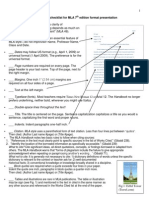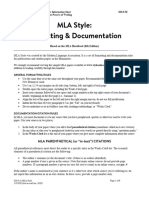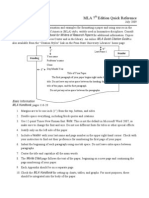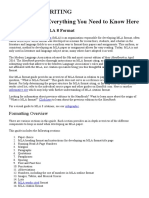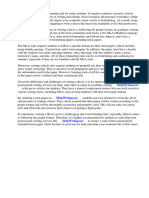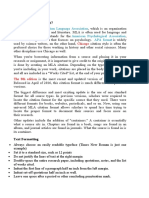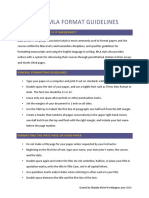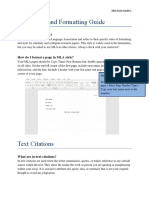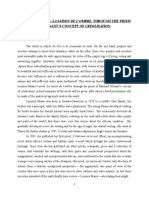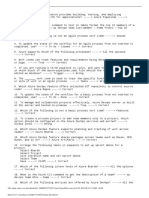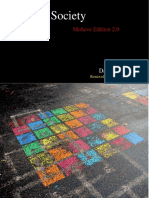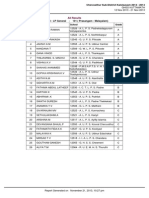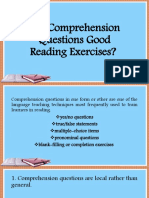MLA BASICS FROM THE WRITING CENTER MLA does not require a title page.
Lastname 1
Format the top left hand corner of your first
page with the information listed here.
First Name Last Name
In title case, you should
Each page should include your last name and
Professor First Name Last Name capitalize only the first
the page number in the top right at ½ inch
letter of each word
from the page border. Note: If your professor has
Course Name and Number requested different formatting, follow your except for articles,
professor’s instructions! prepositions, and
Date conjunctions, unless any
of these words are the
Type Your Title in Title Case first word in the title.
When writing a paper in MLA format, there are a few simple rules you should follow.
Make sure that you use a very clear, simple font. Times New Roman 12 is the preferred font in
MLA style. You should double space your all paragraphs and use bold and italics minimally.
These special styles should be reserved for cases that really require extra emphasis on a word or
phrase. Italics or quotation marks should be used when indicating the title of another work in the
body of your paper. Use one inch borders all
around your paper.
MLA style requires the use of parenthetical citation in the body of your paper. There are
three main ways that you can correctly use parenthetical citation:
1. If you only have one work by a given author an you incorporate the author’s name in
your sentence, the quotation should simply be followed by a page number in parentheses.
For example, Howard states that “[In-text citations] mark each use you make of a source,
regardless of whether you are quoting, paraphrasing, summarizing, or drawing ideas from
[them]” (288). Note also that you can use [square brackets] should you need to change a
word or two to make the quotation fit into the grammatical structure of your sentence.
2. If you do not incorporate the author’s name into the body of your text, the quotation
should be followed by the author’s last name and the page number in parentheses. In
contrast to the first example, this second scenario might look like this: It is critically
� Lastname 2
important that you “mark each use you make of a source, regardless of whether you are
quoting, paraphrasing, summarizing, or drawing ideas from it” (Howard 288).
3. If you paraphrase or use an idea that comes directly from some other source but without a
quotation, you should make note of this by listing the page number of the source in
parentheses after you present the idea. This scenario might look like this: Howard
extensively outlined the requirements for citation in the MLA style (288).
In all three of these scenarios, the reader can use the author and page number information
you provide, along with the Works Cited page, to locate the exact reference you have made.
In addition to the brief quotations mentioned above, you may also feel the need to include
a longer quotation. If you include a longer quotation, you should format it as follows:
Longer
When the text you are quoting takes up more than four lines of your project,
quotations
should be
indent the borrowed material as a block by one inch from the left margin, and
indented
by an
place the parenthetical citation one space after the closing punctuation mark. No
additional
inch from
One inch quotation marks should be used when indenting quoted material as a block.
the left
margin. (Howard 292)
As you write your paper, you want to give the reader additional information without
distracting him/her from the main goals of your writing. Generally, this can be accomplished
with endnotes. To create endnotes, mark the area of the text with a superscript number after the
sentence punctuation just like the number at the end of this sentence.1 At the end of the paper,
before the Works Cited page, include a Notes page. Each note should be numbered to match the
in-text notation; indented five spaces on the first line with no indentation on subsequent lines;
� Lastname 3
and should include a period and a space after each number. In general, footnotes should be
avoided in MLA.
The very last page of any paper should be the bibliography. For MLA style papers,
center the title Works Cited on this page. All citations on this page should be double spaced and
all lines of a given citation, after the first line, should be indented by exactly ½ inch. When
referencing titles, be sure to use Title Case, which means you capitalize only the first letter of
each word except for articles, prepositions, and conjunctions, unless any of those words are the
first word in the title. See the Works Cited page of this document for additional sources you can
use to master the MLA style and information on how to cite some common sources.
� Be sure that the Works Cited title is Lastname 4
centered on the page.
Works Cited
Howard, Rebecca Moore. Writing Matters: A Handbook for Writing and Research. 2nd ed. New
York: McGraw Hill, 2014. Print.
The Purdue OWL. Purdue U Writing Lab, 2010. Web. 27 January 2014.
Here are formats for common sources:
Book with one author
Lastname, Firstname. Title of Book. City of Publication: Publisher, Year of Publication. Print.
Book with two or more authors
Lastname, Firstname, and Firstname Lastname. Title of Book. City of Publication: Publisher,
Year of Publication. Print.
Lastname, Firstname, Firstname Lastname, and Firstname Lastname. Title of Book. City of
Publication: Publisher, Year of Publication. Print.
Book with four or more authors
Include
Lastname, Firstname, et al. Title of Book. City of Publication: Publisher, Year of Publication. “Version
Print. Number”
information
Websites if it is
available.
Editor, author, or compiler name (if available). Name of Site. Version number. Name of This could
institution/organization affiliated with the site (sponsor or publisher), date of resource be a posting
creation (if available). Web. Date of access. date, a
volume
Magazine & Newspaper Articles number, or
(Note that pagination may be a little different in newspapers than magazines.) an issue
number.
Author(s). "Title of Article." Title of Periodical Day Month Year: pages. Print.
Note the ½ inch
indentation on second
and subsequent lines
Other important tips:
1. Alphabetize your Works Cited page by author’s last name.
2. When citing websites, use n.p. to indicate that neither a publisher nor a sponsor name has been provided.
Use n.d. if there is no publication date.
3. Reference an MLA handbook or the Purdue OWL website
(https://owl.english.purdue.edu/owl/resource/747/01/) should you need additional citation information.
















